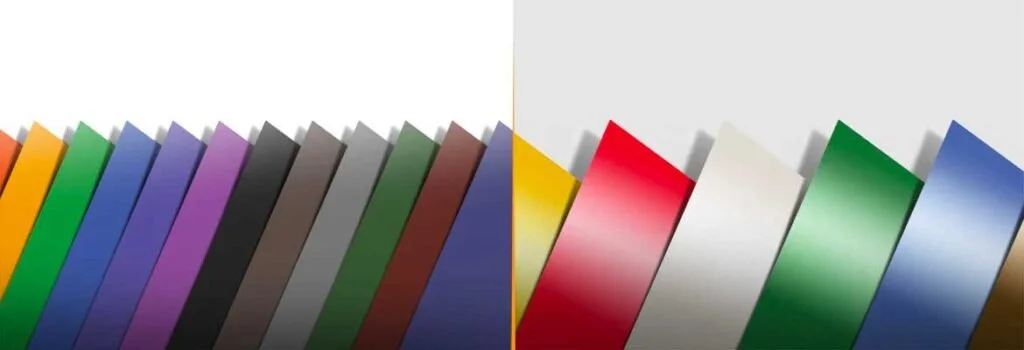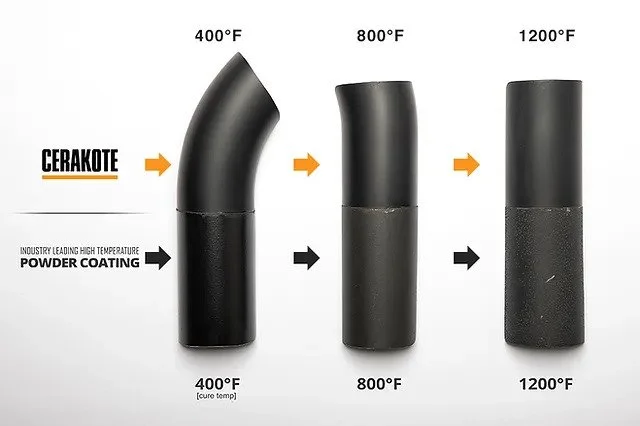unbeatable performance
Cerakote is the worlds leading thin film coating
CERAKOTE vs ANODIZING
Due to the chemicals used in the process, anodizing offers a very limited color selection and can only be used on aluminum and titanium surfaces.
Color consistency is known to vary widely from part to part and batch to batch due to chemical variations and subtle differences in the substrate that cannot be controlled.
Cerakote does NOT detrimentally affect the fatigue properties of aluminum alloys.
The anodizing process creates a brittle and porous oxide layer and tensile residual stress, which detrimentally affects the fatigue properties of aluminum alloys. This fatigue has been widely reported and documented.
CERAKOTE vs CORROSION
Cerakote, a leading coating technology, is renowned for its exceptional corrosion resistance properties. Developed with advanced ceramic formulations, Cerakote provides a durable and protective coating for a wide range of materials, including metals, plastics, and polymers.
The primary purpose of Cerakote is to shield surfaces from the harmful effects of corrosion. Through a unique curing and baking process, this coating creates a tough barrier that acts as a shield against moisture, chemicals, and other corrosive elements. As a result, Cerakote significantly reduces the risk of rust, pitting, and degradation over time.
One of the notable features of Cerakote is its ability to withstand extreme environments and harsh conditions. Whether exposed to saltwater, high humidity, or intense UV radiation, surfaces coated with Cerakote retain their corrosion resistance properties, ensuring long-lasting protection. This makes Cerakote an ideal choice for various applications, such as firearms, automotive parts, outdoor equipment, and industrial machinery.
Moreover, the versatile nature of Cerakote allows for customization options. With a vast array of colors and finishes available, individuals and businesses can not only enhance the corrosion resistance of their products but also achieve an aesthetically pleasing appearance. This customizable aspect makes Cerakote an appealing choice for both functional and design-oriented purposes.
Still unsure? Check out the video above and see for yourself how well Cerakote stands up to the ‘others’
CERAKOTE VS HIGH TEMP POWDER
The Cerakote Advantage
When seeking performance, looks and temperature stability, there is only one coating that stands on the podium for all three at once. Cerakote’s high-temperature coatings are the ultimate solution for parts such as exhausts, headers, turbos and manifolds.
CERAKOTE VS XYlON
We put Cerakote Elite Blackout and Xylan® coated bolts and hex nuts in the salt chamber to test who would finish strong against red-rust corrosion. At 540 hours, the Xylan® coated items reached, per Cerakote Standard ASTM D610, 3% red-rust on the body of the bolts and were left in chamber for later comparison. The Xylan® coated items were pulled from chamber at 1,871 hours due to excessive corrosion. At 4,000 hours, the test was concluded and the Cerakoted items had yet to reach 3% red-rust. Cerakote Blackout corrosion performance showed an 87% improvement over Xylan®.
CERAKOTE VS ABRASION
CERAKOTE vs PVD
In a salt chamber test to simulate corrosion over time, Cerakote Elite outperformed PVD with 330 times the corrosion protection. These results also exceed military standards by over 40 times. Cerakote is a superior performance finish to PVD, at a lower price point, and is made in the USA.
CERAKOTE VS TEFLON
Cerakote Elite Blackout, Teflon® Black 958G and Teflon® Metallic Black 420G coated bolts and hex nuts went heads-up in the salt chamber to see which would outlast the other.
Rust was observed on both of the Teflon® bolts after 24 hours in the salt fog chamber. Per Cerakote standard ASTM D610, the Teflon® Metallic coated items reached 3% red-rust and were left in the chamber for later comparison. At 48 hours, the Teflon® Black items reached 3% red-rust and were also left in chamber for later comparison. Zero rust was observed on the Cerakoted items.







